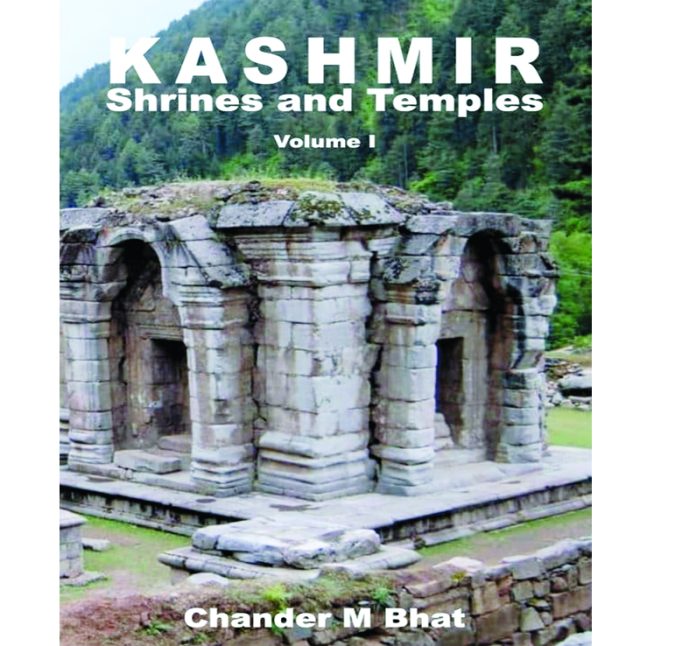Isha Raina
Name of the book: KASHMIR…Shrines and Temples
Volume: 1
Publishers: Shivas Publications
Pages: 493+viii
ISBN: 978-93-340-6016-4
“KASHMIR… Shrines and Temples” by Chander M Bhat is a monumental work that stands as a definitive exploration of the rich religious heritage of Kashmir. It encapsulates over two decades of painstaking research, beginning during the author’s tenure in Srinagar since October 1990. This book is not just a catalogue of sacred sites, but a profound testament to the devotion, perseverance, and dedication of the author, who has braved immense challenges to document the spiritual landscape of Kashmir renowned for its beauty and religious diversity.
Mr. Bhat’s book offers a rare and invaluable glimpse into Kashmir’s religious traditions, which have flourished for centuries. The first volume alone catalogues more than 90 temples, delving into the history, significance, and present condition of each. The scope of this work goes beyond just temples, encompassing shrines, springs, revered trees, lakes, and caves that hold a special place in the hearts of the Kashmiri Pandit community. By capturing these details, the book provides a panoramic view of the diverse spiritual traditions that have shaped the cultural identity of Kashmir.
What makes this endeavor especially significant is the time in which it was undertaken. In 1990, Kashmir was undergoing a period of great turmoil, with political and social unrest affecting all aspects of life, including its religious institutions. This turbulent backdrop makes Mr. Bhat’s documentation efforts even more remarkable, as he was driven by a desire to preserve the sacred heritage of his homeland before it could be lost to time or neglect.
The book is meticulously structured into five distinct sections, each focusing on a specific aspect of Kashmir’s religious heritage:
‘Ancient Temples’ … This section delves into the history, and legends associated with some of Kashmir’s most iconic temples, many of which date back to antiquity. Mr. Bhat provides detailed descriptions, often supported by geographical context and coordinates, offering readers both a historical and contemporary perspective on these ancient structures. ‘Devi Shrines’…Here, the book highlights the reverence for the feminine divine in Kashmiri spirituality. Shrines dedicated to various forms of the Mother Goddess are explored in depth, offering insights into their cultural importance and continued relevance in the spiritual lives of devotees. ‘Shrines and Temples Associated to Lord Shiva’…As a central figure in Kashmiri Shaivism, Lord Shiva holds immense significance, and this section delves into the many shrines and temples associated with the deity. Mr. Bhat’s exploration of these sacred sites is particularly poignant, providing a deeper understanding of Shaivism’s role in the region’s spiritual landscape. ‘Spring Shrines’…Springs have held a special place in Kashmiri spirituality, believed to be imbued with divine qualities. Mr. Bhat documents these revered water bodies, emphasizing their role in both religious rituals and cultural memory and lastly ‘Other Sacred Sites’…This section encompasses a variety of other sites, including the abodes of Bhairavas, revered trees such as elm and mulberry, mountain lakes, and caves. These sites are often lesser-known but hold deep spiritual significance for the Kashmiri Pandit community.
One of the most striking aspects of the book is the author’s resilience in the face of immense challenges. Mr. Bhat’s documentation was not without peril, as he encountered local resistance when attempting to photograph some of these sacred sites. He details confrontations in villages such as Loketpur in Anantnag, Sadhu Ganga in Kupwara, Badipora in Budgam, Guddar near Kulgam, and Monghama in Pulwama. In several instances, mobs of over 500 people confronted him, questioning his motives and creating an atmosphere of hostility. Despite these dangerous situations, Mr. Bhat remained undeterred, driven by his passion to preserve Kashmir’s spiritual legacy for future generations.
Mr. Bhat’s book is a vital contribution to the preservation of Kashmiri culture. In a time when much of the region’s religious and cultural heritage has faced neglect or destruction, “KASHMIR… Shrines and Temples” acts as both a historical record and a call to action. The author’s work underscores the importance of preserving these sacred sites, not just for the Kashmiri Pandit community but for all who value cultural and religious diversity.
The first volume offers a comprehensive exploration of over 90 temples, providing readers with detailed historical context, geographical information, and an assessment of each temple’s current condition. It is clear that Mr. Bhat’s work is exhaustive in its scope, with over 600 shrines and temples catalogued in total. His research extends beyond the physical structures to include the intangible aspects of these sites, such as the myths, legends, and religious practices associated with them.
As Mr. Bhat approaches the release of Volume Two, there is great anticipation for what this next installment will offer. The first volume has set a high standard, and readers can expect the second volume to continue this thorough exploration of Kashmir’s sacred geography. With the promise of further insights into the religious traditions that have shaped the region, Volume Two is sure to be an equally valuable resource for those interested in Kashmir’s spiritual history.
“KASHMIR… Shrines and Temples” is more than just a book…it is a labor of love, a work of immense dedication, and a significant cultural achievement. Chander M Bhat’s exhaustive research and documentation efforts serve as a crucial reminder of the importance of preserving cultural heritage, especially in regions that have faced significant turmoil.
For anyone interested in the religious and cultural history of Kashmir, this book is a must read. It provides an invaluable resource for historians, researchers, and spiritual seekers alike, offering a rare glimpse into a world that is at once ancient and timeless. Through his meticulous documentation, Mr. Bhat ensures that Kashmir’s sacred heritage will be remembered, appreciated, and preserved for generations to come.


